A Distributionally Robust Fusion Framework for Autonomous Multisensor Spacecraft Navigation during Entry Phase of Mars Entry, Descent, and Landing
Abstract
:1. Introduction
1.1. Background
1.2. Contribution
- To our knowledge, this work is the first in the literature to tackle real-time multisensor Mars entry navigation in the face of non-Gaussian measurement noise. This accounts for more realistic measurement scenarios during the lander entry.
- Due to the utilization of additional sensors, the proposed scheme is, to our knowledge, the first to estimate the ballistic coefficient and reference atmospheric density independently and with high accuracy. Other related research works either estimate products of these parameters or require another projectile with a known ballistic coefficient to be launched from the entry vehicle to make the ballistic coefficient observable [21]. Other approaches involve trying to mitigate the effects of unobservable parameters on the state estimation using the considered Kalman filtering [26].
1.3. Contents of the Paper
2. Problem Formulation
2.1. Mars Entry Dynamic Equations of Motion
2.2. Measurement Models
2.2.1. Inertial Measurement Unit (IMU)
2.2.2. Ground-Based Radio Beacon Array
2.2.3. Atmospheric and Aerothermal Sensor Suite
3. Robust Statistical Methods in Estimation
4. Navigation Filter Design
4.1. Established Methods
4.1.1. Extended Kalman Filter (EKF)
| Algorithm 1 EKF |
| Step 0: Initialize state estimate and state estimation error covariance
Step 1: Compute a linearized version of the process equation Step 2: Propagation Step 3: Compute a linearized version of the measurement equation Step 4: Update |
4.1.2. Unscented Kalman Filter (UKF)
| Algorithm 2 UKF |
| Step 0: Initialize state estimate and state estimation error covariance
step 1: Select sigma points is a tuning parameter that can take on any real number as long as . Step 2: Transform sigma points using nonlinear process equation Step 3: Form a priori state estimate and covariance Step 4: Perform measurement update |
4.2. M-Estimation-Based Iterated Extended Kalman Filter (MIEKF)
| Algorithm 3 IEKF |
| Step 0: Initialize state estimate and state estimation error covariance
Step 1: Compute a linearized version of the process equation Step 2: Propagation Step 3: Update Step 3.1: Set iteration count to and initialize IEKF with the prior found from the propagation step Step 3.2: With , until , perform N times where is a user-specified termination threshold. Step 3.3: Return posterior state estimate and estimation error covariance |
| Algorithm 4 MIEKF |
| Step 0: Initialize state estimate and state estimation error covariance
Step 1: Compute a linearized version of the process equation Step 2: Propagation Step 3: Update Step 3.1: Set iteration count to and initialize IEKF with the prior found from the propagation step Step 3.2: With , until , perform N times where is a user-specified termination threshold. Step 3.3: Return posterior state estimate and estimation error covariance |
5. Simulation Experiments
Simulation Settings
6. Results and Discussion
7. Conclusions
Author Contributions
Funding
Data Availability Statement
Acknowledgments
Conflicts of Interest
Appendix A. Coordinate Frame Definitions and Transformations
- (1)
- Mars-centered inertial (MCI) frame ():It is centered on the planet and its z-axis aligned with Mars’s rotation axis, x-axis pointing towards the vernal equinox, and the y-axis completes a right-handed system.
- (2)
- Mars-centered Mars-fixed (MCMF) frame (m):It is fixed to the planet and rotates with it. It shares the same rotation axis with the planet and hence the MCI frame. A rotation of about the MCI frame’s z-axis gives the MCMF frame. The transformation between the two frames is
- (3)
- Vehicle-pointing/position coordinate system (p):It originates at the planet’s center with its x-axis pointing in the direction of the vehicle’s position vector. Its y-axis points parallel to the equatorial plane and its z-axis completes a right-handed system. The transformation from the position coordinate frame to the MCMF frame can be done using the following matrix
- (4)
- Body frame (b):Its origin is the vehicle center of mass. The axes for this frame are configured to align with each axis of symmetry of the entry vehicle. IMU measurements are defined in this coordinate frame.
- (5)
- Velocity frame (v):Its origin is centered on the lander vehicle with its x-axis aligned in the direction of the flight path, its z-axis lies on a local vertical plane orthogonal to the x-axis, and the y-axis completes a right-handed system. The transformation from the velocity frame to the vehicle-pointing frame is given byand the transformation from the velocity frame to the body frame is given bywhere is the bank angle and is the angle of attack of the entry vehicle.
Appendix B. Derivation of the Standard Iterated Extended Kalman Filter (IEKF) via an Optimization Approach
References
- Li, S.; Jiang, X. Review and Prospect of Guidance and Control for Mars Atmospheric Entry. Prog. Aerosp. Sci. 2014, 69, 40–57. [Google Scholar] [CrossRef]
- NASA Technology Taxonomy. 2020. Available online: https://www.nasa.gov/offices/oct/taxonomy/index.html (accessed on 7 December 2022).
- Starek, J.A.; Açikmese, B.; Nesnas, I.A.D.; Pavone, M. Spacecraft Autonomy Challenges for Next-Generation Space Missions. In Advances in Control System Technology for Aerospace Applications; Feron, E., Ed.; Lecture Notes in Control and Information Sciences 460; Springer: Berlin/Heidelberg, Germany, 2016; pp. 1–41. [Google Scholar]
- Yu, Z.; Cui, P.; Crassidis, J.L. Design and Optimization of Navigation and Guidance Techniques for Mars Pinpoint Landing: Review and Prospect. Prog. Aerosp. Sci. 2017, 94, 82–94. [Google Scholar] [CrossRef]
- Braun, R.D.; Manning, R.M. Mars Exploration Entry, Descent, and Landing Challenges. J. Spacecr. Rockets 2007, 44, 310–323. [Google Scholar] [CrossRef] [Green Version]
- Lugo, R.A.; Cianciolo, A.D.; Williams, R.A.; Dutta, S.; Powell, R.W.; Chen, P.T. Integrated Precision Landing Performance and Technology Assessments of a Human-Scale Mars Lander Using a Generalized Simulation Framework. In Proceedings of the AIAA SCITECH 2022 Forum, San Diego, CA, USA, 3–7 January 2022; pp. 1–15. [Google Scholar]
- Cianciolo, A.D.; Striepe, S.; Carson, J.; Sostaric, R.; Woffinden, D.; Karlgaard, C.; Lugo, R.; Powell, R.; Tynis, J. Defining Navigation Requirements for Future Precision Lander Missions. In Proceedings of the AIAA Scitech Forum, San Diego, CA, USA, 7–11 January 2019; pp. 1–18. [Google Scholar]
- Carson, J.; Munk, M.; Sostaric, R.; Johnson, A.; Amzajerdian, F.; Blair, J.B.; Matthies, L. Precise and Safe Landing Navigation Technologies for Solar System Exploration. Bull. AAS 2021, 53, 413. [Google Scholar] [CrossRef]
- Williams, J.W.; Woffinden, D.C.; Putnam, Z.R. Mars Entry Guidance and Navigation Analysis Using Linear Covariance Techniques for the Safe and Precise Landing—Integrated Capabilities Evolution (Splice) Project. In Proceedings of the AIAA Scitech Forum, Orlando, FL, USA, 6–10 January 2020; pp. 1–19. [Google Scholar]
- Woffinden, D.C.; Robinson, S.B.; Williams, J.W.; Putnam, Z.R. Linear Covariance Analysis Techniques to Generate Navigation and Sensor Requirements for the Safe and Precise Landing—Integrated Capabilities Evolution (SPLICE) Project. In Proceedings of the AIAA Scitech Forum, San Diego, CA, USA, 7–11 January 2019. [Google Scholar]
- Prakash, R.; Burkhart, P.D.; Chen, A.; Comeaux, K.A.; Guernsey, C.S.; Kipp, D.M.; Lorenzoni, L.V.; Mendeck, G.F.; Powell, R.W.; Rivellini, T.P.; et al. Mars Science Laboratory Entry, Descent, and Landing System Overview. In Proceedings of the 2008 IEEE Aerospace Conference, Big Sky, MT, USA, 1–8 March 2008; pp. 1–18. [Google Scholar]
- Nelessen, A.; Sackier, C.; Clark, I.; Brugarolas, P.; Villar, G.; Chen, A.; Stehura, A.; Otero, R.; Stilley, E.; Way, D.; et al. Mars 2020 Entry, Descent, and Landing System Overview. In Proceedings of the 2019 IEEE Aerospace Conference, Big Sky, MT, USA, 2–9 March 2019; pp. 1–20. [Google Scholar]
- Blackmore, L.; Açikmeşe, B.; Scharf, D.P. Minimum-Landing-Error Powered-Descent Guidance for Mars Landing Using Convex Optimization. J. Guid. Control Dyn. 2010, 33, 1161–1171. [Google Scholar] [CrossRef] [Green Version]
- Açıkmese, B.; Casoliva, J.; Carson, J.M., III. G-FOLD: A Real-Time Implementable Fuel Optimal Large Divert Guidance Algorithm for Planetary Pinpoint Landing. In Proceedings of the Concepts Approaches Mars Exploration, Houston, TX, USA, 12–14 June 2012. [Google Scholar]
- Bishop, R.H.; Crain, T.P.; Hanak, C.; DeMars, K.; Carson, J.M.; Trawny, N.; Christiank, J. An Inertial Dual-State State Estimator for Precision Planetary Landing with Hazard Detection and Avoidance. In Proceedings of the AIAA Guidance, Navigation, and Control Conference, San Diego, CA, USA, 4–8 January 2016; pp. 1–21. [Google Scholar]
- Lévesque, J.F. Advanced Navigation and Guidance for High-Precision Planetary Landing on Mars. Ph.D. Thesis, University of Sherbrooke, Quebec, QC, Canada, 2006. [Google Scholar]
- Wolf, A.A.; Graves, C.; Powell, R.; Johnson, W. Systems for Pinpoint Landing at Mars. Adv. Astronaut. Sci. 2005, 119, 2677–2696. [Google Scholar]
- Pastor, P.R.; Gay, R.S.; Striepe, S.A.; Bishop, R.H. Mars Entry Navigation from EKF Processing of Beacon Data. In Proceedings of the Astrodynamics Specialist Conference, Denver, CO, USA, 14–17 August 2000; pp. 518–528. [Google Scholar]
- Bishop, R.H.; Dubios-Matra, O.; Ely, T. Robust Entry Navigation using Hierarchical Filter Architectures Regulated with Gating Networks. In Proceedings of the 16th International Symposium on Space Flight Dynamics, Pasadena, CA, USA, 3–6 December 2001. [Google Scholar]
- Marschke, J.M.; Crassidis, J.L.; Lam, Q.M. Multiple Model Adaptive Estimation for Inertial Navigation during Mars Entry. In Proceedings of the AIAA/AAS Astrodynamics Specialist Conference and Exhibit, Honolulu, HI, USA, 18–21 August 2008. [Google Scholar]
- Lévesque, J.F.; De Lafontaine, J. Innovative Navigation Schemes for State and Parameter Estimation during Mars Entry. J. Guid. Control Dyn. 2007, 30, 169–184. [Google Scholar] [CrossRef]
- Wu, Y.; Fu, H.; Xiao, Q.; Zhang, Y. Extension of Robust Three-Stage Kalman Filter for State Estimation during Mars Entry. IET Radar Sonar Navig. 2014, 8, 895–906. [Google Scholar] [CrossRef]
- Xiao, M.; Zhang, Y.; Wang, Z.; Fu, H. Augmented Robust Three-Stage Extended Kalman Filter for Mars Entry-Phase Autonomous Navigation. Int. J. Syst. Sci. 2018, 49, 27–42. [Google Scholar] [CrossRef]
- Yu, Z.; Cui, P.; Zhu, S. Observability-Based Beacon Configuration Optimization for Mars Entry Navigation. J. Guid. Control Dyn. 2015, 38, 643–650. [Google Scholar] [CrossRef]
- Li, S.; Jiang, X.; Liu, Y. High-Precision Mars Entry Integrated Navigation under Large Uncertainties. J. Navig. 2014, 67, 327–342. [Google Scholar] [CrossRef]
- Lou, T.; Fu, H.; Zhang, Y.; Wang, Z. Consider Unobservable Uncertain Parameters Using Radio Beacon Navigation during Mars Entry. Adv. Space Res. 2015, 55, 1038–1050. [Google Scholar] [CrossRef]
- Jiang, X.; Li, S.; Huang, X. Radio/FADS/IMU Integrated Navigation for Mars Entry. Adv. Space Res. 2018, 61, 1342–1358. [Google Scholar] [CrossRef] [Green Version]
- Lugo, R.A.; Karlgaard, C.D.; Powell, R.W.; Cianciolo, A.D. Integrated Flush Air Data Sensing System Modeling for Planetary Entry Guidance with Direct Force Control. In Proceedings of the AIAA Scitech Forum, San Diego, CA, USA, 7–11 January 2019; pp. 1–14. [Google Scholar]
- Karlgaard, C.D.; Stoffel, T.D.; White, T.R.; West, T.K. Data Fusion of In-Flight Aerothermodynamic Heating Measurements Using Kalman Filtering. In Proceedings of the AIAA Aviation 2022 Forum, Chicago, IL, USA, 27 June–1 July 2022; pp. 1–13. [Google Scholar]
- Karlgaard, C.D.; Tynis, J.A. Mars Phoenix EDL Trajectory and Atmosphere Reconstruction Using NewSTEP; NASA/TM-2019-220282; NASA: Washington, DC, USA, 2019. [Google Scholar]
- Karlgaard, C.D.; Korzun, A.M.; Schoenenberger, M.; Bonfiglio, E.P.; Kass, D.M.; Grover, M.R. Mars InSight Entry, Descent, and Landing Trajectory and Atmosphere Reconstruction. J. Spacecr. Rockets 2021, 58, 865–878. [Google Scholar] [CrossRef]
- Karlgaard, C.D.; Kutty, P.; Schoenenberger, M.; Munk, M.M.; Little, A.; Kuhl, C.A.; Shidner, J. Mars Science Laboratory Entry Atmospheric Data System Trajectory and Atmosphere Reconstruction. J. Spacecr. Rockets 2014, 51, 1029–1047. [Google Scholar] [CrossRef]
- Karlgaard, C.D.; Schoenenberger, M.; Dutta, S.; Way, D.W. Mars Entry, Descent, and Landing Instrumentation 2 Trajectory, Aerodynamics, and Atmosphere Reconstruction. In Proceedings of the AIAA Scitech Forum, San Diego, CA, USA, 3–7 January 2022. [Google Scholar]
- Cipra, T.; Romera, R. Robust Kalman Filter and Its Application in Time Series Analysis. Kybernetika 1991, 27, 481–494. [Google Scholar]
- Ruckdeschel, P.; Spangl, B.; Pupashenko, D. Robust Kalman tracking and smoothing with propagating and non-propagating outliers. Stat. Pap. 2014, 55, 93–123. [Google Scholar] [CrossRef] [Green Version]
- Vinh, N.X.; Busemann, A.; Culp, R.D. Hypersonic and Planetary Entry Flight Mechanics; The University of Michigan Press: Ann Arbor, MI, USA, 1980. [Google Scholar]
- Regan, F.J.; Anandakrishnan, S.M. Dynamics of Atmospheric Re-Entry; AIAA Education Series; AIAA: Washington DC, USA, 1993. [Google Scholar]
- Morabito, D.D. The Spacecraft Communications Blackout Problem Encountered during Passage or Entry of Planetary Atmospheres; IPN Progress Report 42-150; NASA: Washington, DC, USA, 2002; pp. 42–150. [Google Scholar]
- Lightsey, E.G.; Mogensen, A.E.; Burkhart, P.D.; Ely, T.A.; Duncan, C. Real-Time Navigation for Mars Missions Using the Mars Network. J. Spacecr. Rockets 2008, 45, 519–533. [Google Scholar] [CrossRef]
- Gazarik, M.J.; Wright, M.J.; Little, A.; Cheatwood, F.M.; Herath, J.A.; Munk, M.M.; Novak, F.J.; Martinez, E.R. Overview of the MEDLI Project. In Proceedings of the 2008 IEEE Aerospace Conference, Big Sky, MT, USA, 1–8 March 2008; pp. 1–12. [Google Scholar]
- Hwang, H.H.; Bose, D.; White, T.R.; Wright, H.S.; Schoenenberger, M.; Kuhl, C.A.; Trombetta, D.; Santos, J.A.; Oishi, T.; Karlgaard, C.D.; et al. Mars 2020 Entry, Descent and Landing Instrumentation 2 (Medli2). In Proceedings of the 46th AIAA Thermophysics Conference, Washington DC, USA, 13–17 June 2016; pp. 1–13. [Google Scholar]
- White, T.R.; Mahzari, M.; Miller, R.A.; Tang, C.Y.; Monk, J.; Santos, J.A.B.; Karlgaard, C.D.; Alpert, H.S.; Wright, H.S.; Kuhl, C. Mars Entry Instrumentation Flight Data and Mars 2020 Entry Environments. In Proceedings of the AIAA SCITECH 2022 Forum, San Diego, CA, USA, 3–7 January 2022; pp. 1–17. [Google Scholar]
- Benito, J.; Mease, K.D. Reachable and Controllable Sets for Planetary Entry and Landing. J. Guid. Control Dyn. 2010, 33, 641–654. [Google Scholar] [CrossRef]
- Kay, S.M. Fundamentals of Statistical Signal Processing: Estimation Theory; Prentice Hall: Hoboken, NJ, USA, 1997. [Google Scholar]
- Van Trees, H.L.; Bell, K.L.; Tian, Z. Detection Estimation and Modulation Theory, Part I: Detection, Estimation, and Filtering Theory; Wiley: Hoboken, NJ, USA, 2013. [Google Scholar]
- Hampel, F.R.; Ronchetti, E.M.; Rousseeuw, P.J.; Stahel, W.A. Robust Statistics: The Approach Based on Influence Functions; Wiley: Hoboken, NJ, USA, 2005. [Google Scholar]
- Maronna, R.A.; Martin, R.D.; Yohai, V.J.; Salibiàn-Barrera, M. Robust Statistics: Theory and Methods (with R); Wiley: Hoboken, NJ, USA, 2019. [Google Scholar]
- Zoubir, A.M.; Koivunen, V.; Ollila, E.; Muma, M. Robust Statistics for Signal Processing; Cambridge University Press: Cambridge, UK, 2018. [Google Scholar]
- Huber, P.; Ronchetti, E.M. Robust Statistics; Wiley: Hoboken, NJ, USA, 2009. [Google Scholar]
- Bell, B.M.; Cathey, F.W. The Iterated Kalman Filter Update as a Gauss—Newton Method. IEEE Trans. Autom. Contr. 1993, 38, 294–297. [Google Scholar] [CrossRef]
- Maybeck, P.S. Stochastic Models, Estimation and Control; Academic Press: New York, NY, USA, 1982; Volume 2. [Google Scholar]
- Simon, D. Optimal State Estimation: Kalman, H Infinity, and Nonlinear Approaches; Wiley-Interscience: Hoboken, NJ, USA, 2006. [Google Scholar]
- Julier, S.J.; Uhlmann, J.K. Unscented Filtering and Nonlinear Estimation. Proc. IEEE 2004, 92, 401–422. [Google Scholar] [CrossRef] [Green Version]
- Zarchan, P.; Musoff, H. Fundamentals of Kalman Filtering: A Practical Approach, 4th ed.; American Inst of Aeronautics & Astronautics: Reston, VA, USA, 2015. [Google Scholar]
- Havlík, J.; Straka, O. Performance Evaluation of Iterated Extended Kalman Filter with Variable Step-Length. J. Phys. Conf. Ser. 2015, 659, 12022. [Google Scholar] [CrossRef]
- Skoglund, M.A.; Hendeby, G.; Axehill, D. Extended Kalman Filter Modifications Based on an Optimization View Point. In Proceedings of the International Conference on Information Fusion, Washington, DC, USA, 6–9 July 2015. [Google Scholar]

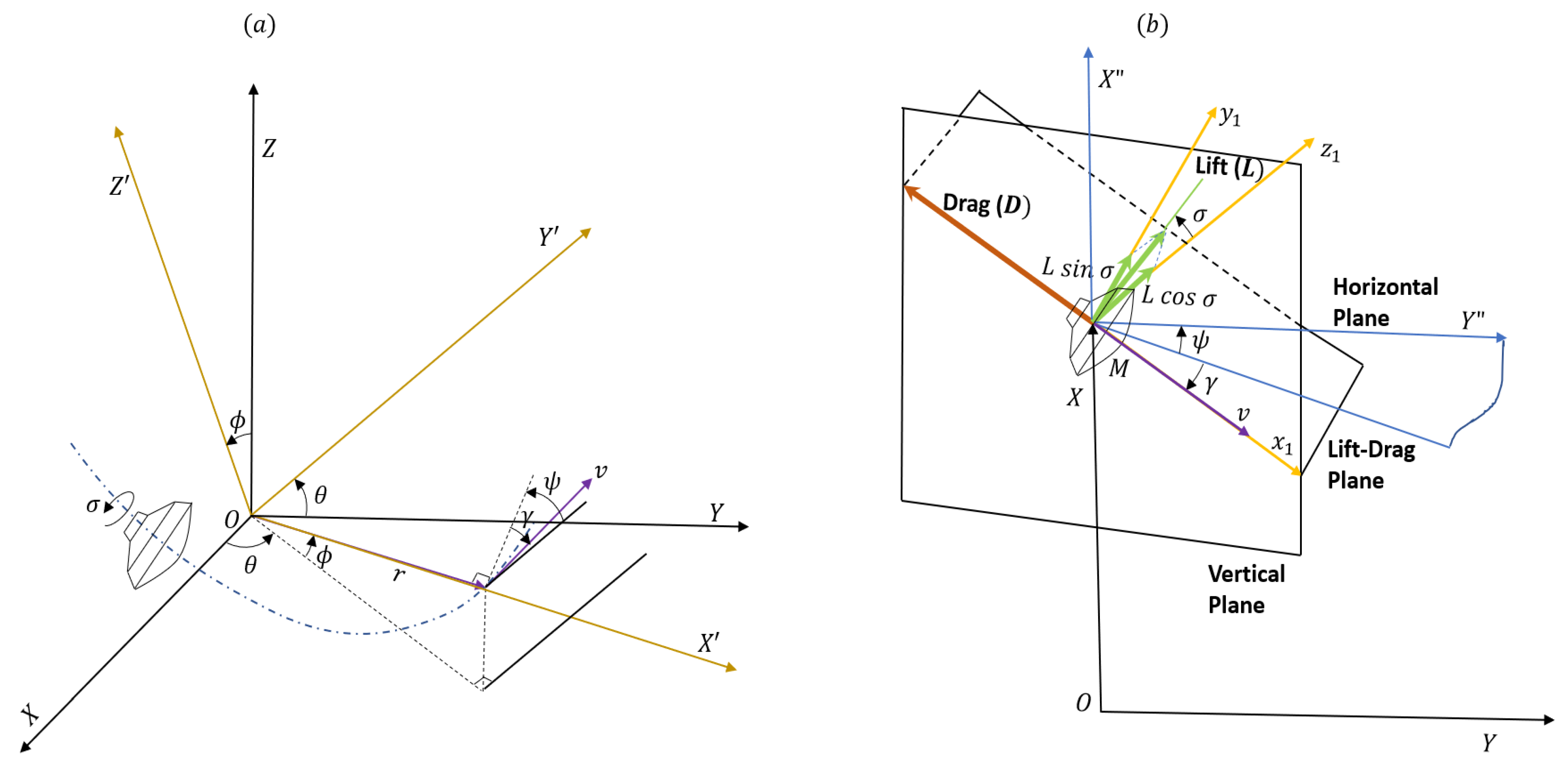

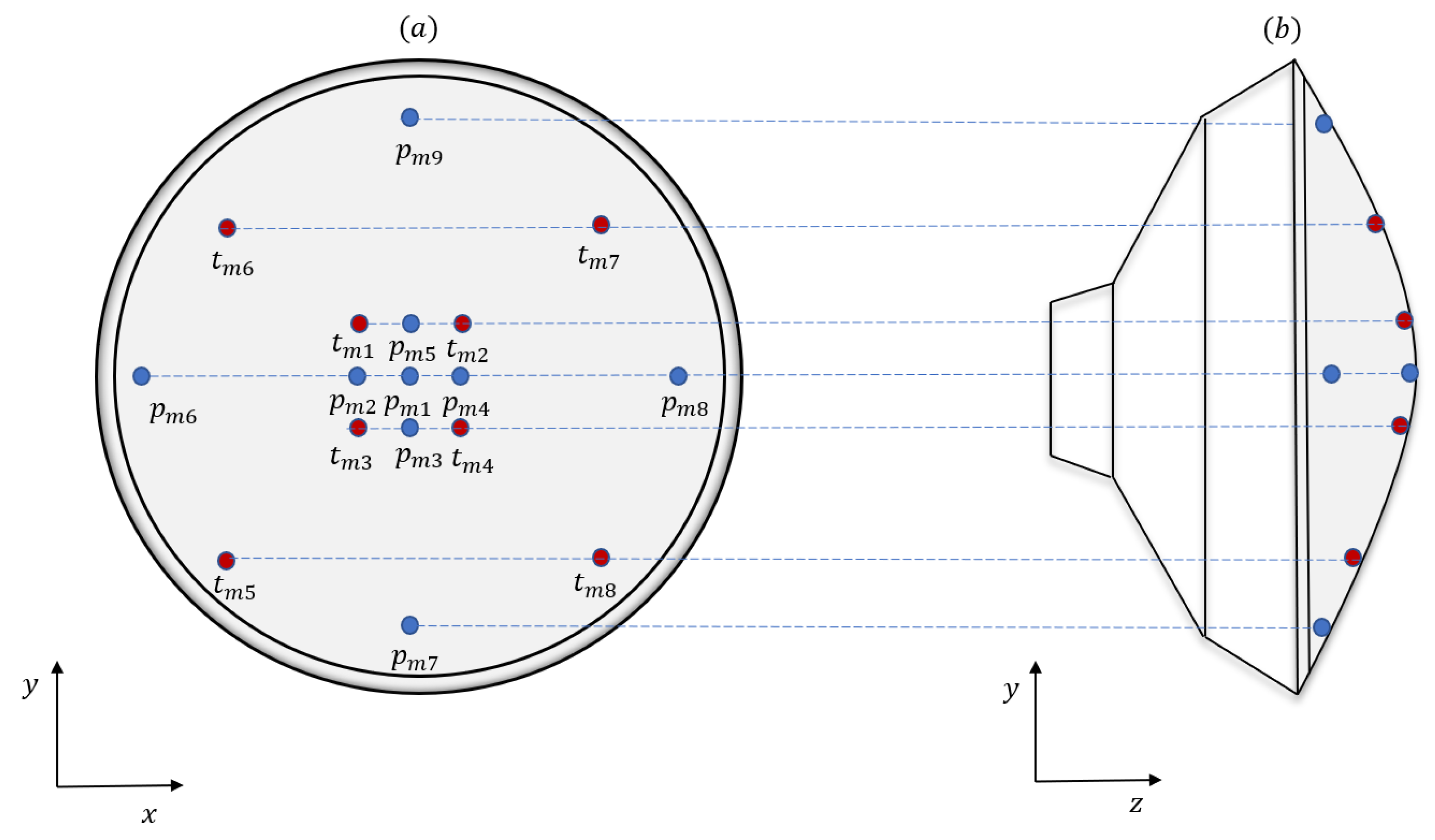
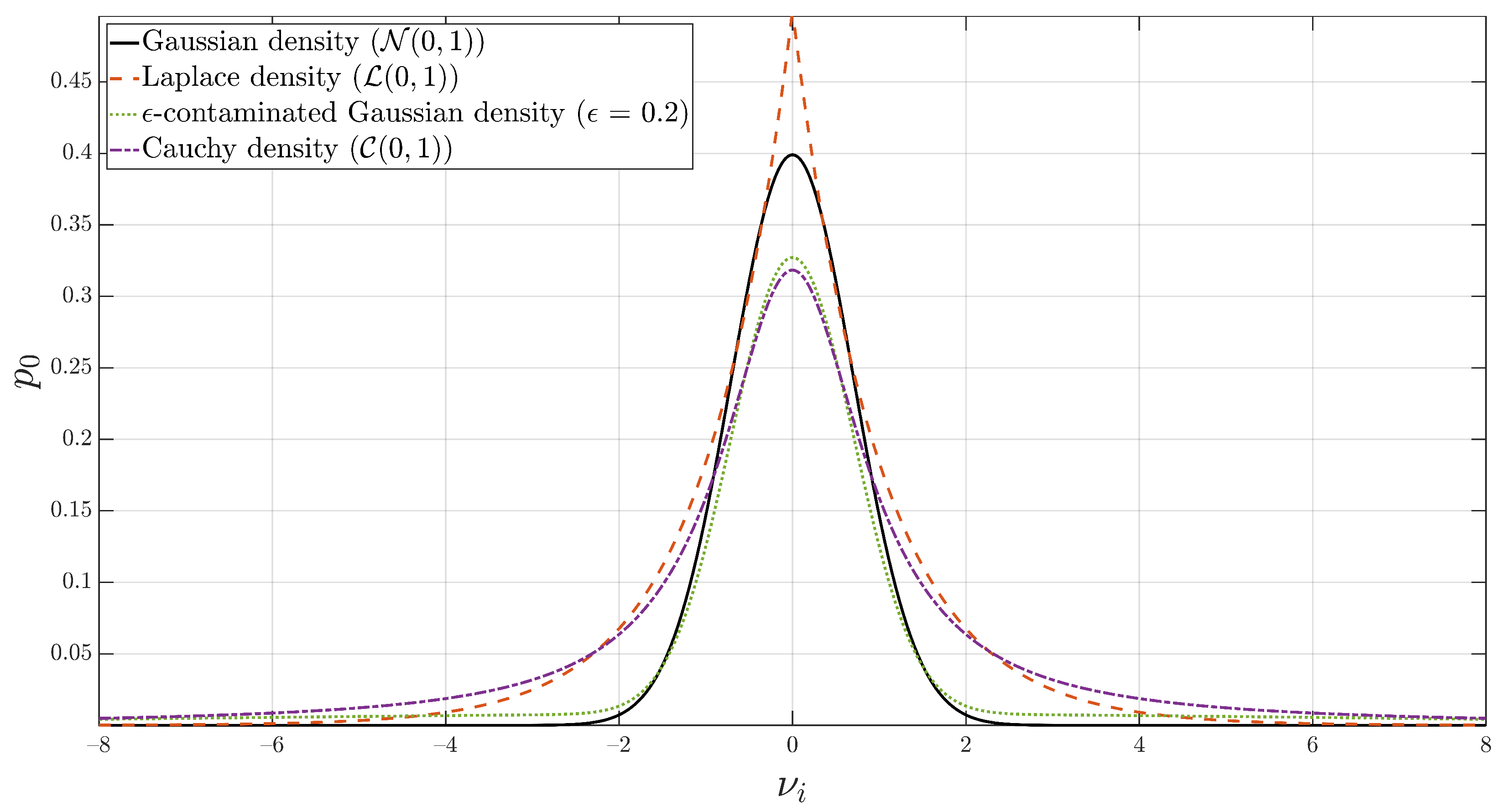

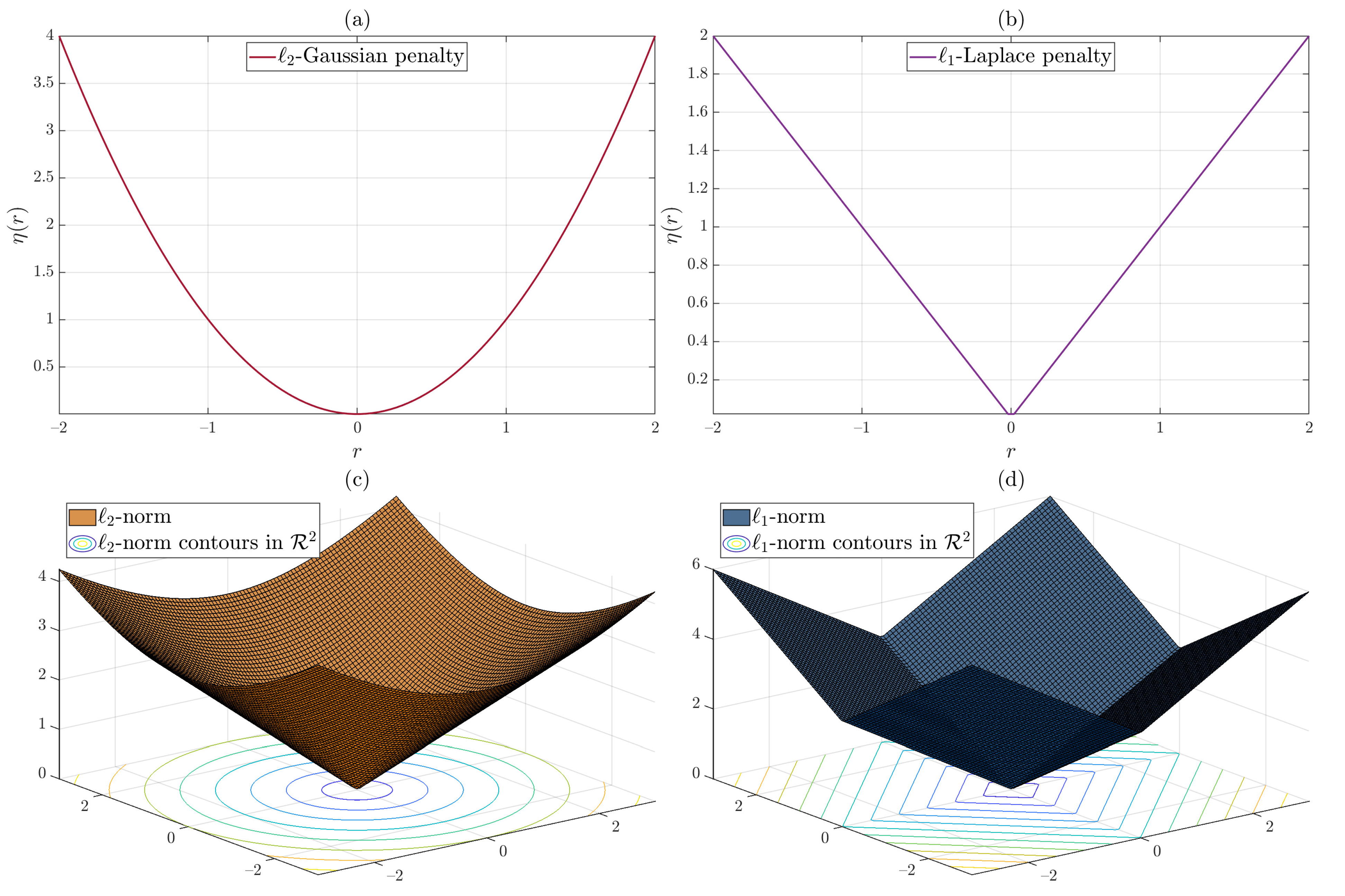





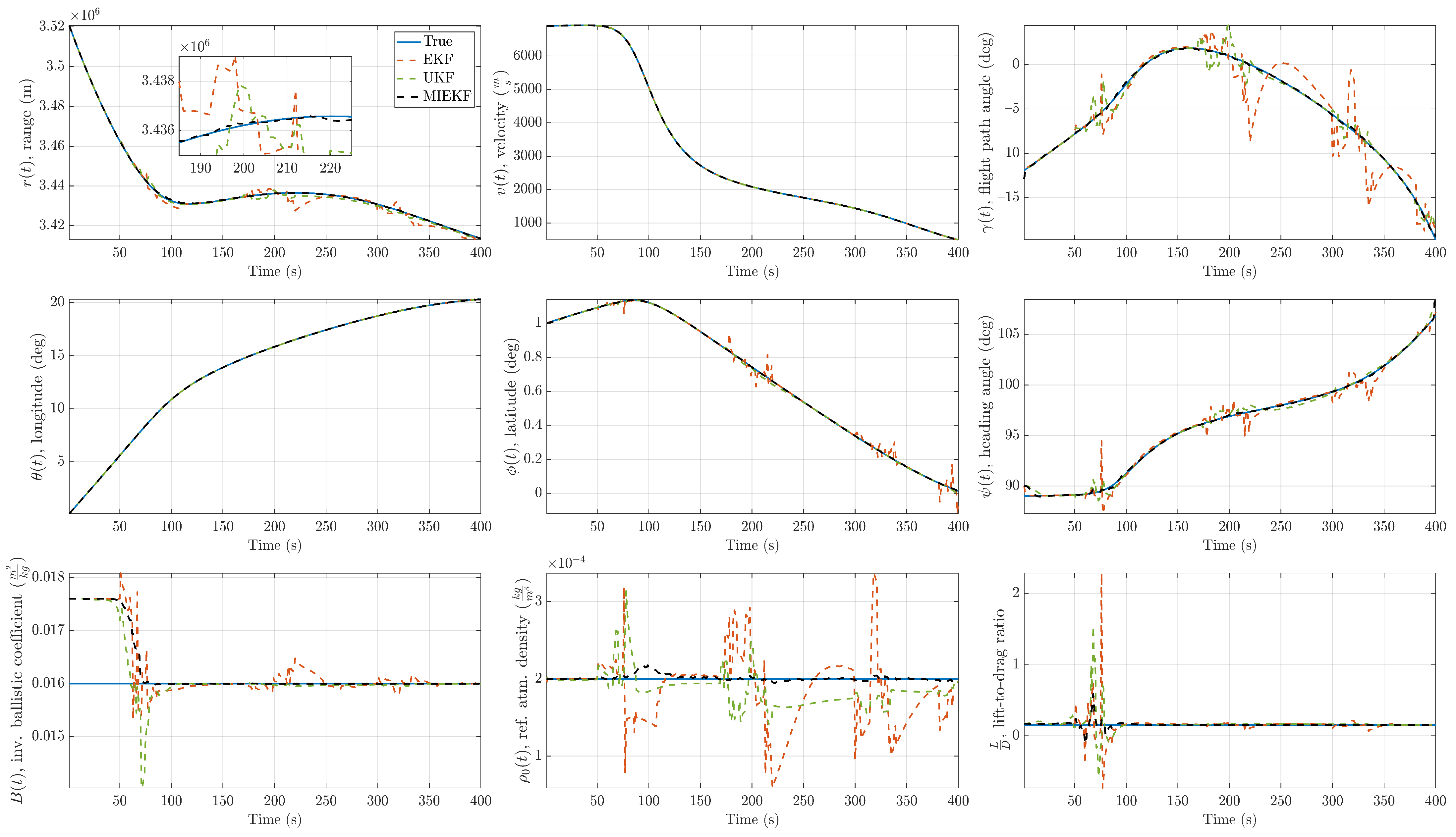
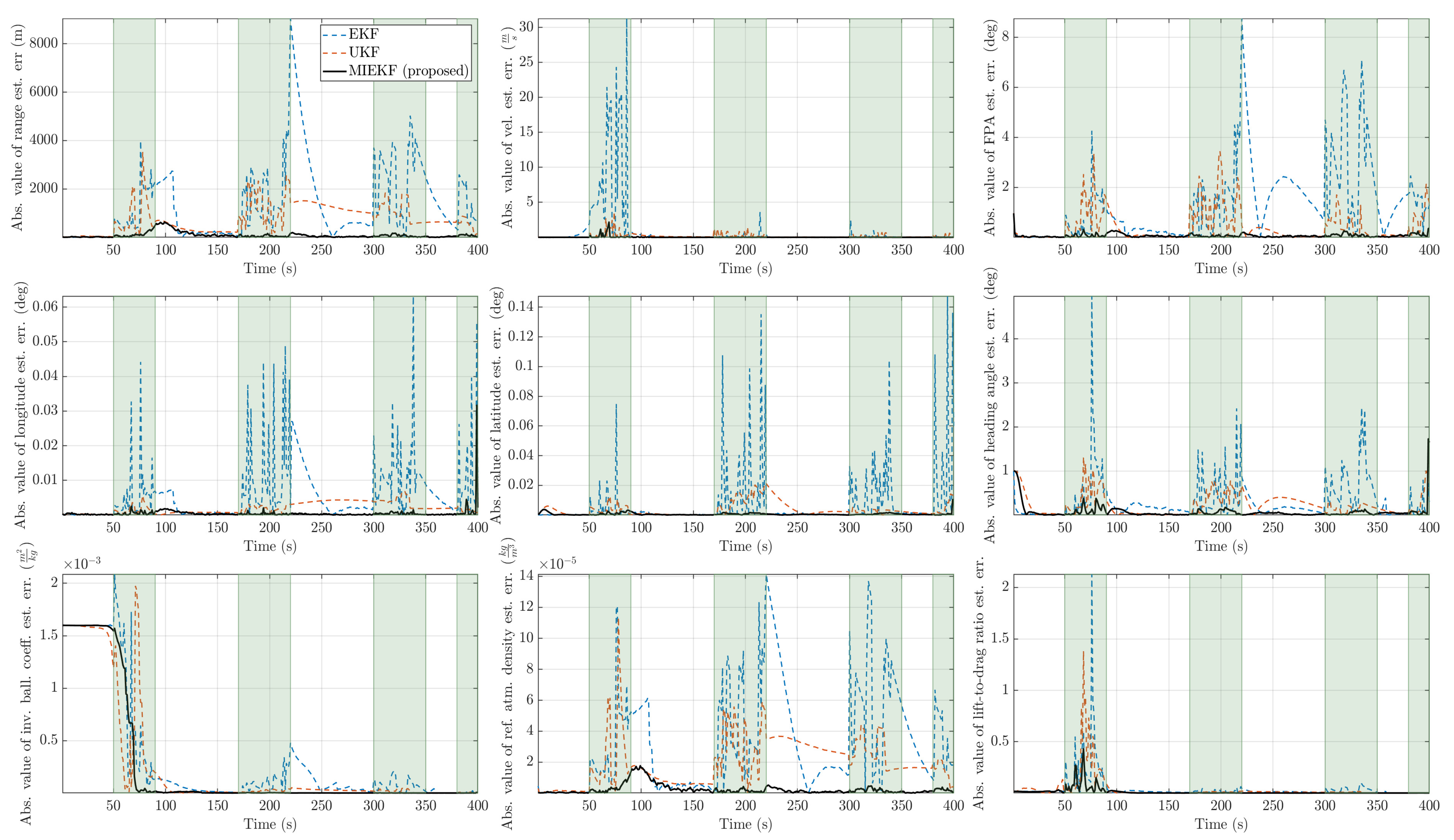
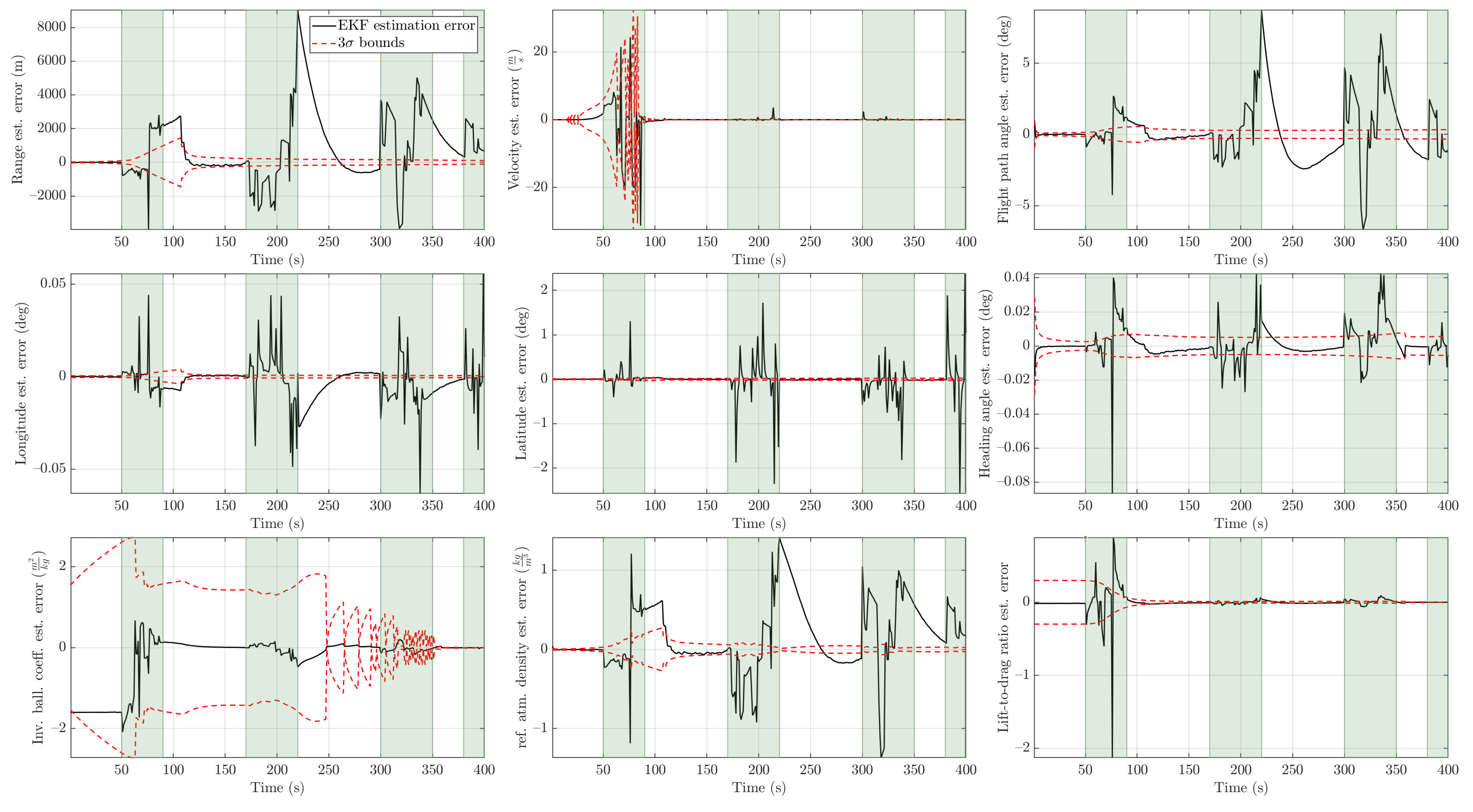
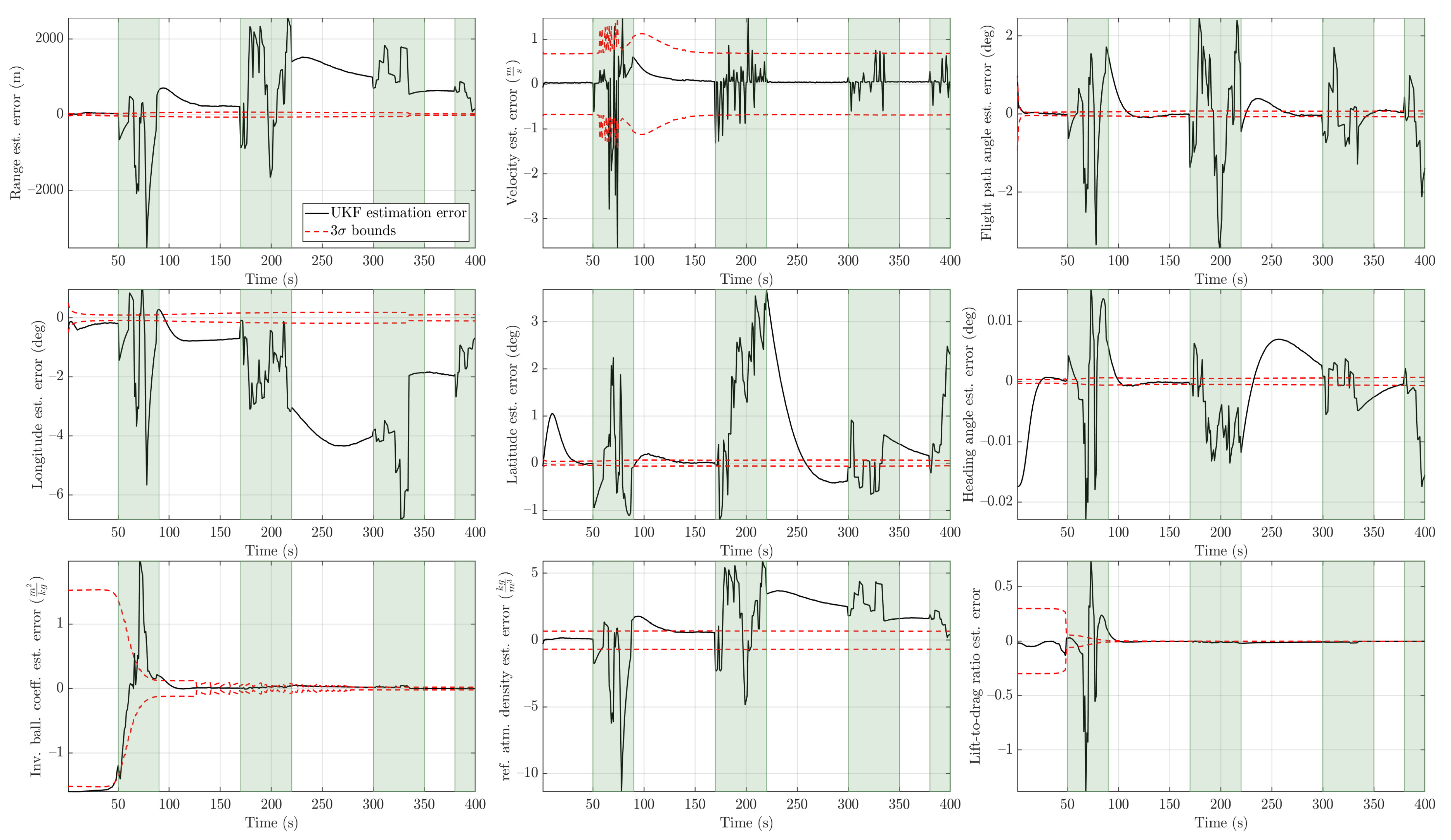
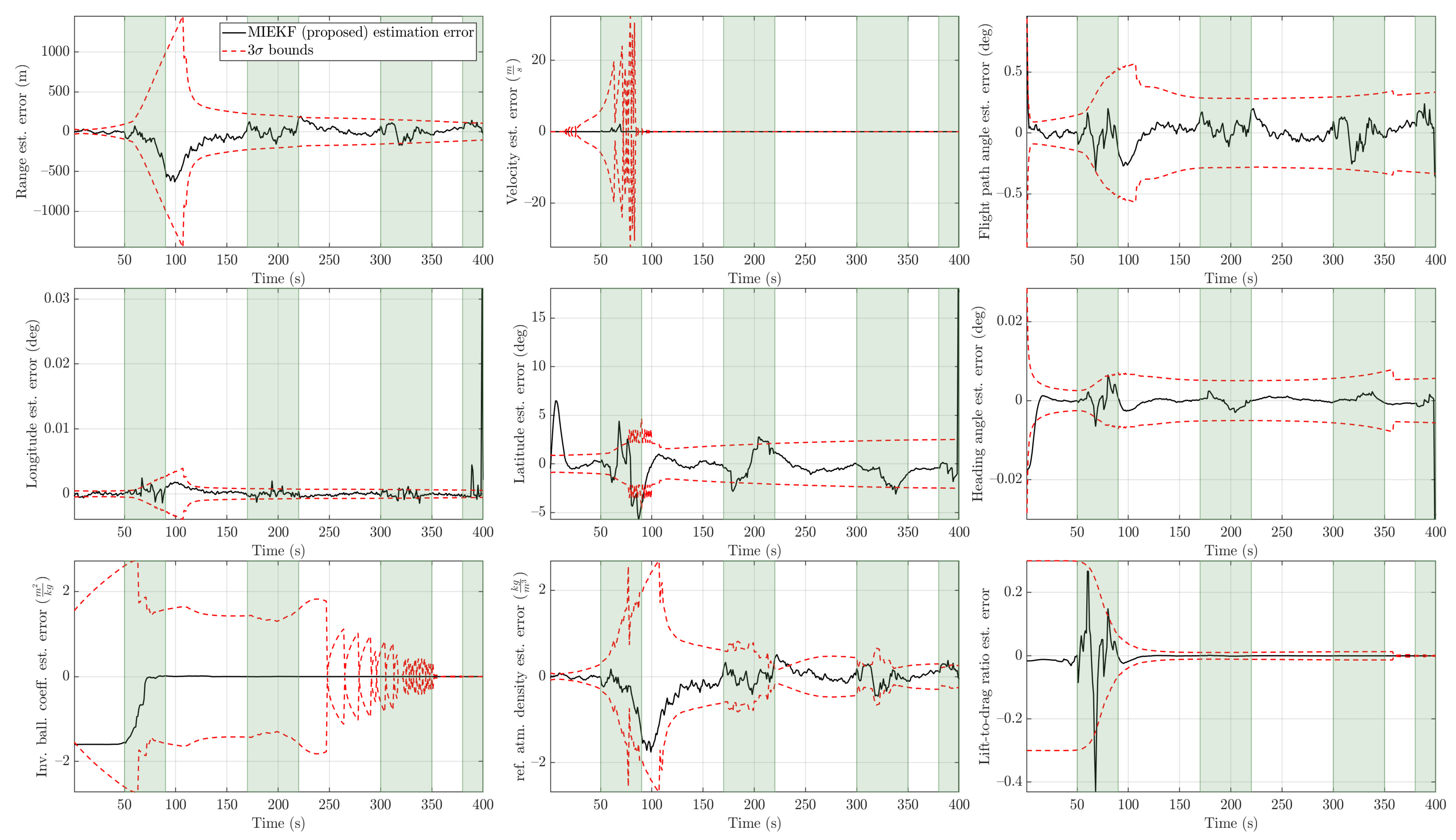

| State/Parameter | Initial True State | Initial Filter State |
|---|---|---|
| Range (km) | 3522.2 | 3521.2 |
| Velocity () | 6900 | 6910 |
| Flight path angle (deg) | −12 | −13 |
| Longitude (deg) | 0 | 0.02 |
| Latitude (deg) | 1 | 1.02 |
| Heading angle (deg) | 89 | 90 |
| Inv. ball. coeff. () | 0.016 | 0.0176 |
| Ref. atmospheric density () | ||
| Lift-to-drag ratio | 0.156 | 0.172 |
| Longitude (deg.) | Latitude (deg.) | |
|---|---|---|
| Beacon 1 | 0 | 0 |
| Beacon 2 | 5.7 | 5.7 |
| Beacon 3 | −5.7 | 5.7 |
| = 0.05 (5% Outlier Level) | = 0.20 (20% Outlier Level) | = 0.40 (40% Outlier Level) | |||||||
|---|---|---|---|---|---|---|---|---|---|
| State/Param. | EKF | UKF | MIEKF | EKF | UKF | MIEKF | EKF | UKF | MIEKF |
| Range, r (m) | 555.4604 | 443.6054 | 1023.6361 | 616.3866 | 1883.3481 | 812.8448 | |||
| Vel., v () | 0.9395 | 0.1408 | 1.1502 | 0.2433 | 3.5284 | 0.3599 | |||
| FPA, (deg) | 0.6831 | 0.2771 | 1.1463 | 0.5762 | 1.9735 | 0.7493 | |||
| Long., (deg) | 0.0043 | 0.0018 | 0.0068 | 0.0018 | 0.01052 | 0.00169 | |||
| Lat. (deg) | 0.0110 | 0.0017 | 0.0162 | 0.0033 | 0.0206 | 0.0055 | |||
| Heading., (deg) | 0.1947 | 0.1814 | 0.2795 | 0.2908 | 0.4493 | 0.3357 | |||
| Inv. Ball. Coeff., B () | 0.000573 | 0.000562 | 0.000580 | 0.000563 | 0.000589 | 0.000578 | |||
| Ref. atm. density, () | 0.000016 | 0.0000011 | 0.000026 | 0.000018 | 0.000042 | 0.000021 | |||
| Lift-to-drag ratio, | 0.008955 | 0.040039 | 0.065336 | 0.113399 | 0.143800 | 0.130166 | |||
Disclaimer/Publisher’s Note: The statements, opinions and data contained in all publications are solely those of the individual author(s) and contributor(s) and not of MDPI and/or the editor(s). MDPI and/or the editor(s) disclaim responsibility for any injury to people or property resulting from any ideas, methods, instructions or products referred to in the content. |
© 2023 by the authors. Licensee MDPI, Basel, Switzerland. This article is an open access article distributed under the terms and conditions of the Creative Commons Attribution (CC BY) license (https://creativecommons.org/licenses/by/4.0/).
Share and Cite
Zewge, N.S.; Bang, H. A Distributionally Robust Fusion Framework for Autonomous Multisensor Spacecraft Navigation during Entry Phase of Mars Entry, Descent, and Landing. Remote Sens. 2023, 15, 1139. https://doi.org/10.3390/rs15041139
Zewge NS, Bang H. A Distributionally Robust Fusion Framework for Autonomous Multisensor Spacecraft Navigation during Entry Phase of Mars Entry, Descent, and Landing. Remote Sensing. 2023; 15(4):1139. https://doi.org/10.3390/rs15041139
Chicago/Turabian StyleZewge, Natnael S., and Hyochoong Bang. 2023. "A Distributionally Robust Fusion Framework for Autonomous Multisensor Spacecraft Navigation during Entry Phase of Mars Entry, Descent, and Landing" Remote Sensing 15, no. 4: 1139. https://doi.org/10.3390/rs15041139
APA StyleZewge, N. S., & Bang, H. (2023). A Distributionally Robust Fusion Framework for Autonomous Multisensor Spacecraft Navigation during Entry Phase of Mars Entry, Descent, and Landing. Remote Sensing, 15(4), 1139. https://doi.org/10.3390/rs15041139






